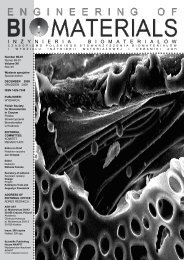69-72 - Polskie Stowarzyszenie BiomateriaÅów
69-72 - Polskie Stowarzyszenie BiomateriaÅów
69-72 - Polskie Stowarzyszenie BiomateriaÅów
Create successful ePaper yourself
Turn your PDF publications into a flip-book with our unique Google optimized e-Paper software.
18<br />
Zastosowania stopu Ti-6Al-4V<br />
w Inżynierii tkanki kostnej<br />
R. Kucharski¹, Fr.-W. Bach¹, S. Blazewicz 2 , J. Chlopek 2 ,<br />
D. Bormann¹<br />
1<br />
Uniwersytet im. Leibniza w Hanowerze,<br />
Instytut Nauki o Materiałach,<br />
An der Universitaet 2, D-30823 Garbsen, Niemcy<br />
2<br />
Akademia Górniczo-Hutnicza,<br />
Wydział Inżynierii Materiałowej i Ceramiki<br />
al. Mickiewicza 30, 30-059 Kraków, Polska<br />
e-mail: kucharski@iw.uni-hannover.de<br />
Streszczenie<br />
Główną wadą implantów na bazie stopów tytanu<br />
przeznaczonych dla chirurgii kostnej, wymagających<br />
długoczasowej stabilności, jest niedopasowanie<br />
struktury powierzchni implantu do otaczającej tkanki.<br />
Przy implantach stawu biodrowego może to prowadzić<br />
do aseptycznego obluzowania się endoprotezy.<br />
Funkcjonalne dopasowanie implantu jako otwartoporowatej<br />
struktury, która obejmuje cały implant lub<br />
tylko powierzchnię, może sprzyjać procesowi wzrostu<br />
tkanki kostnej w pory implantu lub prowadzić do jego<br />
mechanicznego zakotwiczenia.<br />
W pracy przedstawiono wyniki badań nad spiekaniem<br />
proszków Ti-6Al-4V o wielkości ziarn 35µm. Proces<br />
spiekania prowadzono w gradiencie temperatury<br />
w atmosferze gazu obojętnego. Metoda ta pozwalała<br />
otrzymywać mikrostruktury o otwartych porach, które<br />
mogą być wykorzystane do konstrukcji implantów ze<br />
stopów tytanu o podwyższonej trwałości i zdolności<br />
do fiksacji z tkanką kostną.<br />
Słowa kluczowe: stopy tytanu, implanty kostne,<br />
inżynieria tkanek, otwarte struktury metalicznie, proces<br />
spiekania.<br />
[Inżynieria Biomateriałów, <strong>69</strong>-<strong>72</strong>, (2007), 18-22]<br />
Wprowadzenie<br />
W Instytucie Nauki o Materiałach Uniwersytetu w Hanowerze<br />
prowadzi się badania nad otrzymywaniem metalicznych<br />
gąbek z mikrostrukturą otwartych porów. Mają<br />
one m.in. na celu rozszerzenie zastosowań grupy metali<br />
lekkich takich jak stopy tytanu w szeroko rozumianej inżynierii<br />
biomedycznej. Tym samym zapoczątkowano badania<br />
nad materiałami nieresorbowalnymi dla osteosyntezy.<br />
Otrzymywanie otwartoporowatych struktur tytanu może<br />
bazować na znanej technologii, która była zastosowana do<br />
otrzymywania otwartoporowatych struktur, ale z materiałów<br />
resorbowalnych np. stopów magnezu lub też nowej technologii<br />
opartej o różnotemperaturowe spiekanie w kąpieli<br />
gazu ochronnego.<br />
Podstawą technologii pierwszej jest metoda infiltracji<br />
z zastosowaniem wypełniacza ceramicznego [1-3] z tą<br />
różnicą, że temperatura topnienia wypełniacza leży w<br />
przypadku nieresorbowalnego stopu tytanu nieznacznie<br />
powyżej temperatury liquidus metalu. Jako wypełniacz dla<br />
otwartoporowatej struktury tytanowej stosuje się fosforek<br />
wapnia lub tlenek aluminium. Ten ostatni charakteryzuje się<br />
znacznie wyższą temperaturą topnienia niż metaliczna matryca,<br />
a w zakresie 6-9 pH jest nieaktywny, co może wywołać<br />
problemy w procesie jego chemicznego płukania. Metoda<br />
druga wykorzystuje aktywacje energii termicznej podczas<br />
Application of Ti-6Al-4V for<br />
Tissue Engineering<br />
R. Kucharski¹, Fr.-W. Bach¹, S. Blazewicz 2 , J. Chlopek 2 ,<br />
D. Bormann¹<br />
1<br />
Leibniz University of Hanover,<br />
Institute of Materials Science,<br />
An der Universität 2, D-30823 Garbsen, Germany<br />
2<br />
AGH-UST, Faculty of Materials Science and Ceramics,<br />
al. Mickiewicza 30, 30-059 Cracow, Poland<br />
e-mail: kucharski@iw.uni-hannover.de<br />
Abstract<br />
The main reasons for the failure of titanium based<br />
alloy bone implants requiring long term stability is the<br />
incompatibility of the implant’s surface structure and<br />
the growth rate of natural bone tissue. In the case of<br />
a hip joint endoprosthesis, this leads to an aseptic<br />
loosening of the endoprosthesis.<br />
Functional adaptation of the implant as an open<br />
pored structure, which either extends over the whole<br />
implant or exists only on its surface, presents the<br />
possibility for the bone tissue to grow into the implant<br />
and provide mechanical anchorage for the implant in<br />
the bone. In the present work, the results of investigations<br />
and the sintering process using 35µm size<br />
powder grains of the alloy Ti-6Al-4V are presented.<br />
A sintering process was chosen as a manufacturing<br />
method using a selected temperature gradient and<br />
an inert scavenging gas. This method of manufacture<br />
produced open pored structures whose properties<br />
can be transferred to a larger group of applications of<br />
metallic long term implants for osteosynthesis.<br />
Keywords: titanium alloys, bone implants, tissue<br />
engineering, open pored metallic structures, sintering<br />
process<br />
[Engineering of Biomaterials, <strong>69</strong>-<strong>72</strong>, (2007), 18-22]<br />
Introduction<br />
At the Institute for Materials Science (IW) Leibniz University<br />
of Hanover, open pored metallic sponges have been<br />
developed and investigated. The investigations so far were<br />
based on the application of materials manufactured for biomedical<br />
technology and were expanded to include a new<br />
group of light metals; the titanium alloys. For this reason,<br />
the investigations on non-reabsorbing materials for osteosynthesis<br />
were started at the IW.<br />
The manufacture of open pored titanium structures is<br />
based on known technology that was used in the production<br />
on resorbable open pored metallic structures. According to<br />
this infiltration method, a ceramic spacer was used [1-3],<br />
the difference being that the melting temperature of the<br />
ceramic spacer for the non-resorbable titanium alloys is<br />
slightly higher than the metal’s liquidus temperature. Calcium<br />
phosphate and aluminium oxide are available as ceramic<br />
spacers for the open pored structure. Since aluminium oxide,<br />
which possesses a considerably higher melting point than<br />
the metallic matrix, is chemically inactive within the pH-interval<br />
from 6 to 9, it can however present problems during<br />
the spacer’s chemical washing procedure.<br />
In order to bind the spherical particles of the experimental<br />
alloy together, a sintering process with an inert scavenging<br />
gas was selected. Specific properties of the titanium alloy<br />
(table 1), in particular the formation of a titanium oxide













